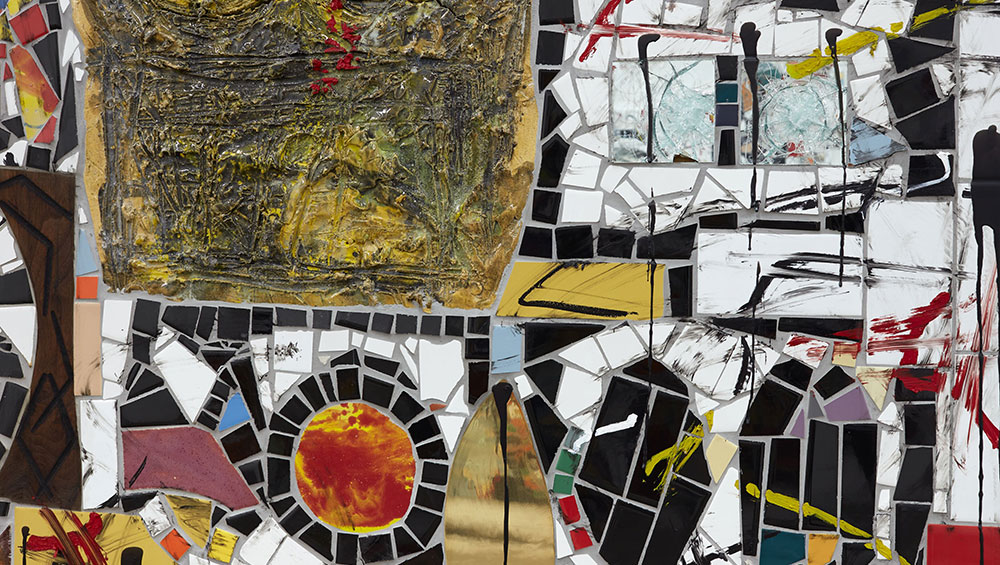
© Rashid Johnson. Courtesy the artist and Hauser & Wirth.
Hauser & Wirth London
6 October – 23 December 2020
In line with government guidance the gallery is currently closed
by VERONICA SIMPSON
Fresh out of the Art Institute of Chicago as a photography major, Rashid Johnson (b1977, Chicago) got his first break exhibiting three photographic portraits for the Studio Museum in Harlem’s 2001 exhibition “freestyle”, curated by Thelma Golden, on the theme of “post-black” culture. Now established as a leading US conceptual and multidisciplinary contemporary artist - he recently added mainstream movie director to his achievements, with a visceral and affecting adaptation of Native Son winning critical acclaim at last year’s Sundance Film Festival - the influence of photography has prevailed. In a 2016 interview with Conceptual Fine Arts, he said: “Photography is inherently a subtractive medium. It’s performed; you push a button and take an image. You’re capturing an image, stealing an image. That language is very interesting. A lot of the ways that I play with painting and sculpture is about that kind of reduction. It’s about taking material away.”
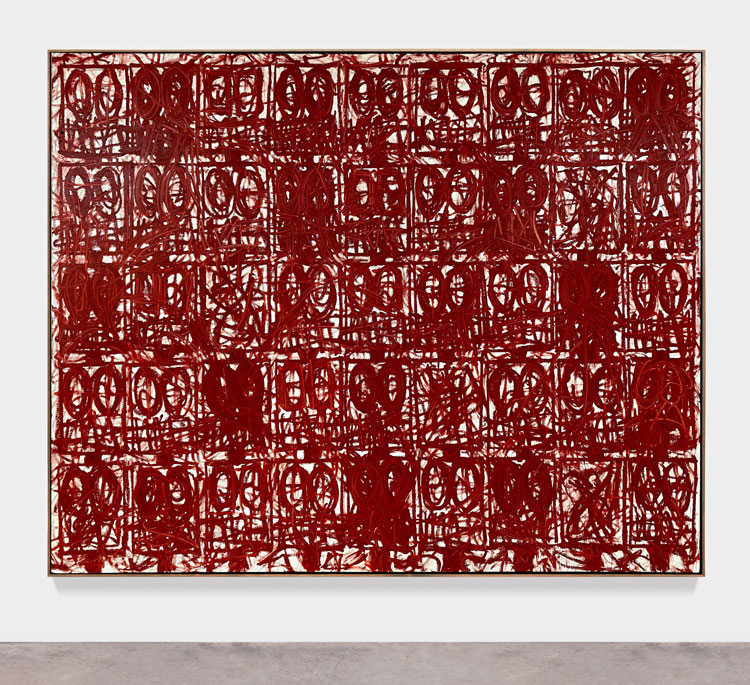
Rashid Johnson. Anxious Red Painting August 20th, 2020. Oil on linen, 239.1 x 305.1 x 5.1 cm. Photo: Martin Parsekian. © Rashid Johnson. Courtesy the artist and Hauser & Wirth.
At the time of that interview, he was referring to his Anxious Men series, for which the motif of skull-like faces on a grid was typically achieved by pouring a trademark Johnson material – black soap mixed with wax – on to a grid of white tiles, then scraping and scratching the material away to create hollow-eyed, grotesque visages. For his 2016 Hauser & Wirth New York show, these grids were multiplied to create his Anxious Audiences series. And that motif is very much present in his current London show, though the compulsion toward subtraction has evolved. Four years down the line, his response to the coronavirus pandemic is a series of red, monolithic oil paintings featuring row upon row of smeary, staring faces, painted in Johnson’s specially formulated tone of “Anxious Red”.
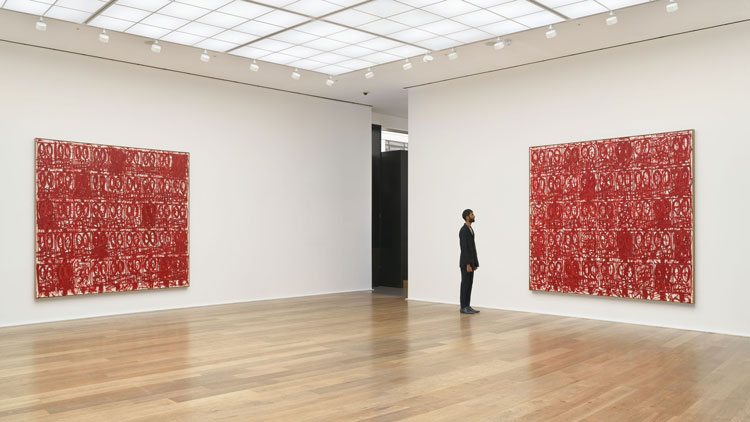
Rashid Johnson. Waves, installation view, Hauser & Wirth, London, 2020. © Rashid Johnson. Courtesy the artist and Hauser & Wirth.
Both the London galleries are dedicated to Johnson’s work, with these self-explanatory-titled Anxious Red Paintings appearing in a small, white cube configuration of one gallery, one per wall, facing in towards each other. They were all painted during lockdown, in August this year, and the paint is layered, smeared and gouged across the grid formation, each work looking pretty much like the other, so that the eye is superficially overwhelmed by that colour, and this motif. The mood reeks of anger as well as anxiety - appropriate for these days, especially if you are American, and trebly so an African American. I am neither, though hopefully highly attuned to their particular current political, economic and cultural challenges. Given that sympathy, I wait for a really strong sucker punch of a reaction to hit home, faced with these rows of angry red people, but it fails to materialise. The repetition of almost identical patterns, in one colour, across the same-sized, monolithic surfaces, seems to dull the impact. Or maybe I needed to spend longer in the room.
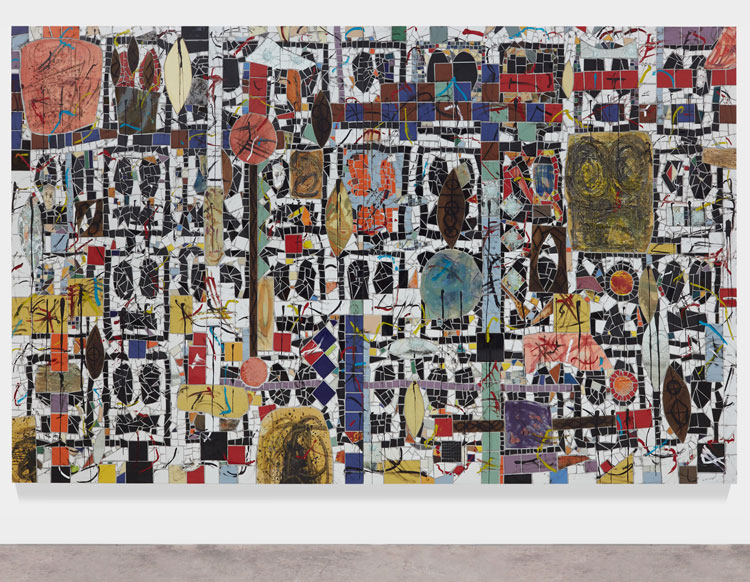
Rashid Johnson. Broken Crowd, 2020. Ceramic tile, mirror tile, spray enamel, oil stick, black soap, wax, 240.7 x 403.9 x 3 cm. Photo: Martin Parsekian. © Rashid Johnson. Courtesy the artist and Hauser & Wirth.
Moving on to the large, corner gallery, we find his new Broken Crowd series of huge mosaic works crammed with scraps of branded wood, bronze, seashells, mirror tiles and ceramics, and soiled with streaks of paint or great, dung-coloured waxy blobs. Johnson has made a virtue of deploying everyday objects in his works – plants, steel grids, shelves, wooden floorboards, cocoa butter - in ways that play with their symbolic and cultural references. He has talked, also, of wanting to incorporate the odd, everyday charms of tiled, hygienic surfaces, the quotidian material of domestic bathrooms or communal steam rooms; places of restoration and relaxation, and escape – another strong Johnson theme.
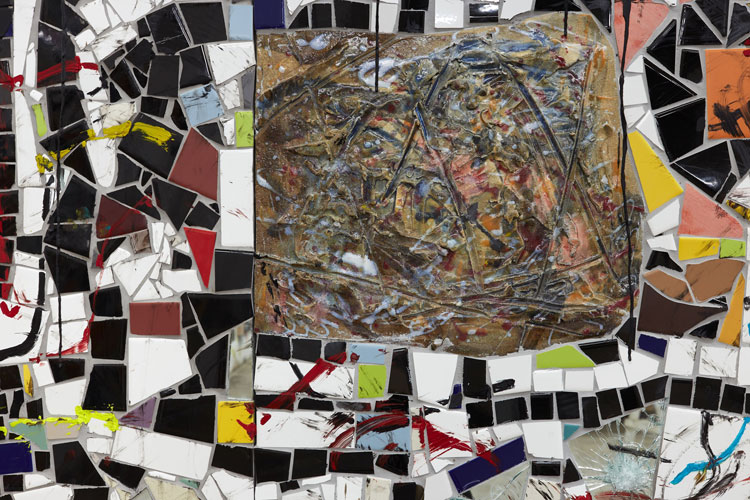
Rashid Johnson. Broken Crowd, 2020 (detail). Ceramic tile, mirror tile, spray enamel, oil stick, black soap, wax, 294.6 x 491.5 x 7.6 cm. Photo: Martin Parsekian. © Rashid Johnson. Courtesy the artist and Hauser & Wirth.
However, the disjointed, constructed/deconstructed figures represented in these mosaics are anything but restful. These works are superficially far more ordered, more obsessively “put together” than the slapdash exuberance of his usual collaged pieces. For example, there are few great, splashy dribbles of black melted soap and wax – a joyful gesture regularly splurged on many a Johnson art piece or installation - though there are multiple veins of spray paint, which, along with the multitude of splinterings and fragmentations, create a jittery mesh between each figure. The labyrinthine qualities of the surface, up close, are distracting; there is so much to take in. Standing a few paces back, however, the broken quality of each figure, against that visual mash-up, takes on a new kind of frantic energy.
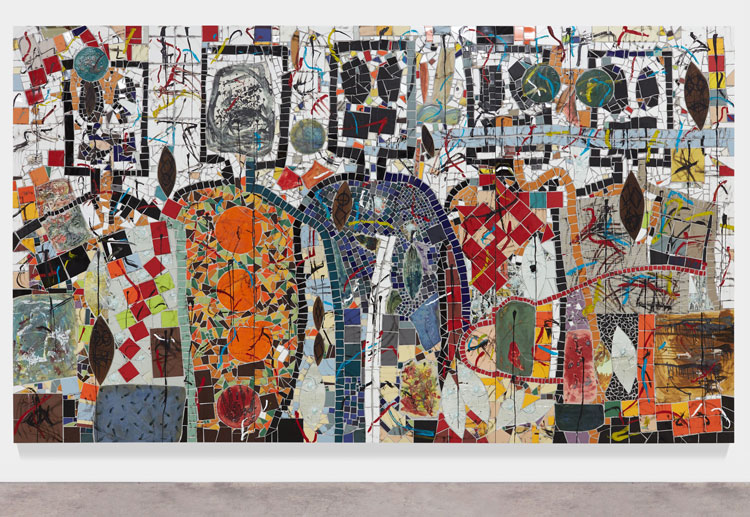
Rashid Johnson. The Broken Five, 2020. Ceramic tile, mirror tile, spray enamel, oil stick, black soap, wax, 250.2 x 430.5 cm. Photo: Martin Parsekian. © Rashid Johnson. Courtesy the artist and Hauser & Wirth.
Each work here features groups of figures, in pairs, multitudes or in one case, in a group of five, in a work titled The Broken Five (2020) – a configuration he has acknowledged, in interviews, that may have been influenced by the Central Park Five case, an historic example of systemic racism by the New York police most recently and powerfully dramatised by Ava DuVernay (in the Netflix documentary When They See Us). However, given the uniform quality and variety of their materials and deployment, there seems little, beyond the addition or subtraction of a figure, to differentiate between any of these works. The figures are barely relating to each other except through similarity and proximity; there is nothing in their posture or attire to indicate any connection. Their faces are turned resolutely outward. This serves to diminish any engagement with the figures, and seems to mask any deeper narrative.
Later, on reflection, it occurs to me that this blank-eyed orientation towards the viewer is perhaps an evocation of that Johnson-esque theme of escape. He has talked about his work addressing the human need for distraction destroying or disrupting our focus on more important, even vital issues, both in the context of pressing socio-political crises and in terms of the everyday, all-day assaults on our attention, thanks to our digitised lives. These blank faces turned towards the viewer may be an evocation of that relentless, screen-ward gaze. Are they, in fact, a cry for help - an articulation of how disconnected we have all become from each other and the core, redemptive qualities of being human, especially as we binge-watch our way through a global pandemic. Now I feel uncertain whether it is my fault or the artist’s that, if there is any greater, deeper message within the work, I find myself too distracted by all the superficial, extraneous detail to see it.